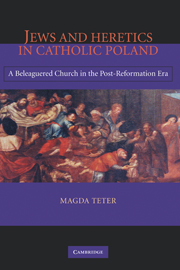Book contents
- Frontmatter
- Contents
- List of Illustrations
- Preface and Acknowledgments
- Note on Terms, Spelling, and Translations
- Abbreviations
- JEWS AND HERETICS IN CATHOLIC POLAND
- Introduction
- 1 “One Mystical Body … Only One Shepherd”: The Church Ideals of Social Order
- 2 The Upset Social Order: Nobles and the Jews in Poland
- 3 Heresy and the Fleeting “Triumph of the Counter-Reformation”
- 4 “Bad and Cruel Catholics”: Christian Sins and Social Intimacies Between Jews and Christians
- 5 “A Shameful Offence”: The Nobles and Their Jews
- 6 “Countless Books Against Common Faith”: Catholic Insularity and Anti-Jewish Polemic
- 7 “Warding Off Heretical Depravity”: “Whom Does the Catholic Church Reject, Condemn and Curse?”
- Conclusion: Did the Counter-Reformation Triumph in Poland?
- Glossary
- Notes
- Selected Bibliography
- Index
3 - Heresy and the Fleeting “Triumph of the Counter-Reformation”
Published online by Cambridge University Press: 12 January 2010
- Frontmatter
- Contents
- List of Illustrations
- Preface and Acknowledgments
- Note on Terms, Spelling, and Translations
- Abbreviations
- JEWS AND HERETICS IN CATHOLIC POLAND
- Introduction
- 1 “One Mystical Body … Only One Shepherd”: The Church Ideals of Social Order
- 2 The Upset Social Order: Nobles and the Jews in Poland
- 3 Heresy and the Fleeting “Triumph of the Counter-Reformation”
- 4 “Bad and Cruel Catholics”: Christian Sins and Social Intimacies Between Jews and Christians
- 5 “A Shameful Offence”: The Nobles and Their Jews
- 6 “Countless Books Against Common Faith”: Catholic Insularity and Anti-Jewish Polemic
- 7 “Warding Off Heretical Depravity”: “Whom Does the Catholic Church Reject, Condemn and Curse?”
- Conclusion: Did the Counter-Reformation Triumph in Poland?
- Glossary
- Notes
- Selected Bibliography
- Index
Summary
Catholic church legislation against jews often did not stand alone but coincided with the rise of heretical movements within the Church itself. This was true of the 1215 regulations of the IV Lateran Council promulgated in the midst of the Church's battle against various heresies in Europe, and of the 1555 papal bull Cum Nimis Absurdum, which established the Roman ghetto during the crisis of the Reformation. In Poland the Church reacted in similar ways. According to surviving sources, regulations of Jewish-Christian interaction – first promulgated at the Council of Breslau in 1267 and ordering a geographic segregation between Jews and Christians – did not reappear in Poland until the first half of the fifteenth century when, in the wake of the heresy of Jan Hus in Bohemia, Huss's followers moved north into the Polish territories, thereby posing a challenge to the Church in Poland.
Reacting to the Hussite heresy, the 1420 provincial synod held at Kalisz and Wieluń issued a number of decrees against heresy and recommended a number of “remedies” to combat it, requiring, among other things, that secular authorities cooperate with the Church in combating its spread. The “heresy” apparently affected mostly the literate elites. One paragraph of the 1420 synodal laws ordered confiscation of the books of those suspected of heresy when they were captured, but in pre-print culture, only a few could afford to own books.
- Type
- Chapter
- Information
- Jews and Heretics in Catholic PolandA Beleaguered Church in the Post-Reformation Era, pp. 41 - 58Publisher: Cambridge University PressPrint publication year: 2005



